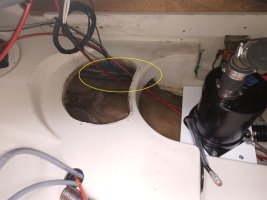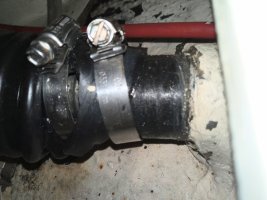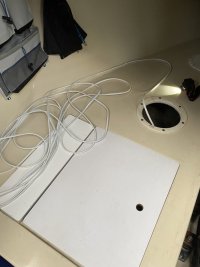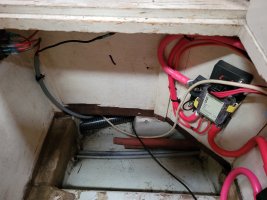I've considered installing centrifugals in my 32-3 as well, but the plumbing difficulties have deterred me from taking on the project yet.
FYI: From the 1985 Ericson 32-3 manual: "Two electric bilge pumps are provided as standard. Both are of the submersible type. One drains the shower sump and is located in the shower sump which is accessible....... The other, of larger capacity, is located in the bilge sump beneath the cabin sole in the main salon."
So, the Rule-type pumps were standard (that's not to say a buyer couldn't pay for upgraded pumps from the factory).
In the 32-3, the two 3/4" bilge pump hoses run through the TAFG (via PVC conduit) until the engine compartment, then they run below the TAFG, on the port side of the engine, until they exit the TAFG in the lazarette, as you mentioned. Apparently, with the 32-200, Ericson had the hoses rise above the TAFG in the engine compartment, so diaphragm pumps could be mounted to the starboard side-wall of the engine compartment. I think the closest you can get to that in a 32-3 is to intercept the hoses outboard of the water heater (shown below, with the water heater removed) and re-route the hoses to a place of your choosing for pump installation.

Also, as a point of curiosity, I don't know why emotions on this site rise so high against Rule pumps. Universal diesels and Kenyon Mast sail tracks have their issues, too, but I don't hear people here referring to them as "junk." I cleaned all my bilges/hoses, removed any check-valves, and replaced & re-wired all my Rule pumps and float switches. Not only do they de-water the boat faithfully--I haven't had a failure in the last 6 years--and, at a lower power consumption than diaphragm pumps, but a Rule 800 and a Rule 500 literally saved my boat from sinking when my PSS ruptured in 2020. When TowBoat US finally arrived 5 days later (due to holiday closures of any haul-out facilities), the first thing they did was throw an emergency bilge pump and hose on-board (yes, it was a Rule 2000 centrifugal). Their pump never activated because my pumps had the situation under control.

Ruptured PSS
Certainly, diaphragm pumps may have some advantages over centrifugals, just as, say, a Yanmar, or electro-propulsion may have over a Universal/Kubota. Just as certainly, that does not make a Rule or a Kubota junk. I'll install a diaphragm pump myself someday, but for now it's pretty low on my priority list.






